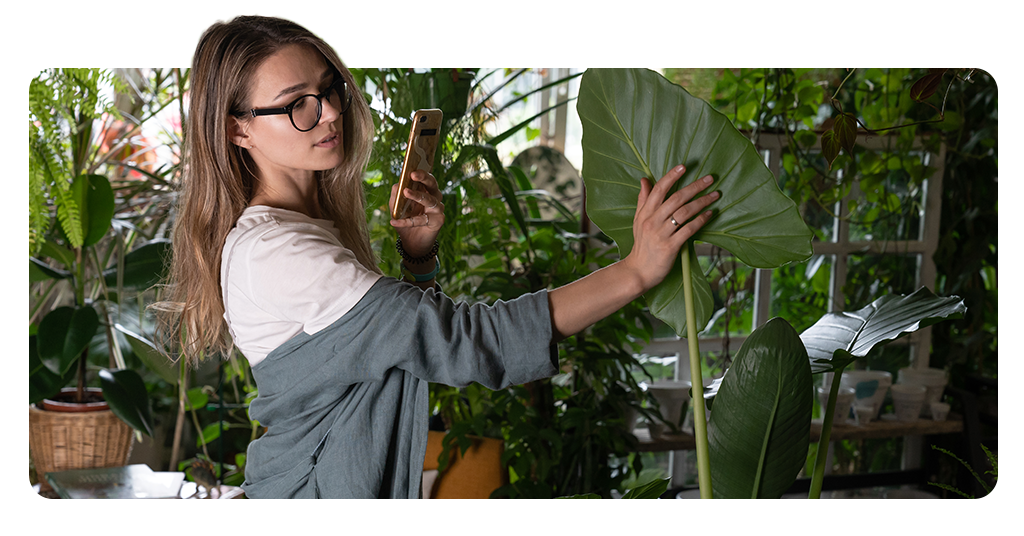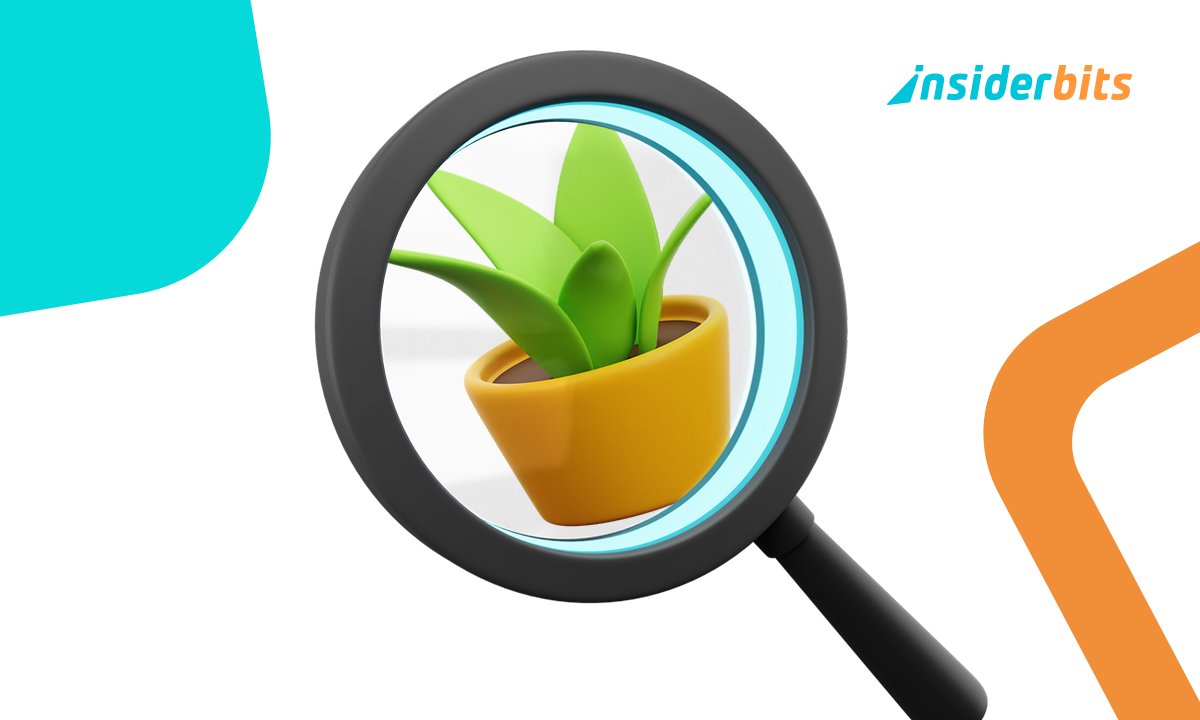Look at a leaf. Notice the shape, the texture, the color. Now imagine knowing its name in seconds. Some apps help identify trees using only a simple photo. These tools fit easily into quiet walks, weekend hikes, or garden moments. They invite attention to small things and help connect everyday surroundings to something bigger and more alive.
This guide by Insiderbits brings together useful features, thoughtful tips, and ways to observe more closely. Keep reading and see what you can discover just by looking.
Related: Urban Foraging Apps: Rediscovering Nature’s Bounty in 2025
How to identify trees by leaves, flowers, and bark
Walking through a park or forest often sparks curiosity. That tall tree with delicate blossoms or rough bark might have a story, and now it’s easy to uncover it.
Each tree has visual clues. The veins in a leaf, the shape of a flower, or the texture of bark can signal a lot. These traits can help you identify trees naturally.
Modern apps use those visible signs to bring answers in seconds. With just a photo, they match patterns, shapes, and colors to offer accurate, educational results on the spot.
Point, snap, identify: how plant recognition works in seconds
Smartphone apps use image recognition trained on thousands of species. Once you snap a photo, the app compares it instantly to a database and offers likely matches.
Some apps go further, giving confidence ratings, alternative species, or even pronunciation tips. It feels fast because it is. Just a moment, and you’ve turned curiosity into discovery.
What leaves, flowers, and bark reveal about each species
Leaves can reveal if a tree is broadleaf or needle-bearing, evergreen or deciduous. Their shape, edge, and color narrow things down more than most people expect.
Flowers offer seasonal insights. Their color, size, and structure are closely linked to specific species. Bark tells age, defense mechanisms, and texture traits that also help identify them.
Tips for taking the perfect identification photo outdoors
A good photo makes all the difference when using an app to identify trees and other plants. Lighting, angle, and focus can determine how accurate your result will be.
- Use natural light only: artificial lighting distorts color. For best results, take photos outdoors in daylight with no flash or added filters;
- Avoid blurry close-ups: hold your phone still and tap the screen to focus before taking the picture. Sharpness helps the app analyze key details;
- Frame the subject clearly: don’t include other plants or objects. The leaf, flower, or bark should be the only focus to avoid confusion;
- Capture more than one part: try photographing both a leaf and bark from the same tree. The more information you give, the better the ID;
- Watch out for shadows: shade from your body or branches can make patterns less visible. Step aside to let sunlight reach the plant clearly.

How to identify trees with the best apps for nature lovers
Some apps turn a simple walk into a mini discovery session. A quick snapshot is enough for your phone to deliver useful information about the tree right in front of you.
These tools are designed for curious minds. With clean interfaces and smart features, they help users connect more deeply with nature while building knowledge in a fun, accessible way.
PictureThis – Plant Identifier
PictureThis makes it simple to identify trees and other plants with just one photo. The app was designed for beginners and curious nature lovers who want fast, visual answers.
Beyond identification, the app offers care tips, plant health analysis, and seasonal insights. Each scan unlocks detailed facts, ideal for anyone trying to learn without complicated terms.
PictureThis also saves every plant you scan, building a custom log of your finds. It works fast, looks clean, and turns everyday walks into something much more rewarding.
PictureThis’ best features
- Instant plant scans: take a photo and get detailed information within seconds, without needing to type or search manually;
- Smart visual recognition: uses AI to match thousands of species accurately, helping users quickly and confidently name plants on the go;
- Personal plant library: saves all previous identifications in a visual journal, making it easy to revisit and learn from past discoveries anytime.
4.8/5
PlantNet
PlantNet helps identify trees by comparing your photo with real examples. Snap a plant, submit it, and get suggestions from a growing database shaped by users and scientists.
The app doesn’t rely solely on artificial intelligence. It connects your image to a living archive of native species, offering detailed matches that vary by region and season.
Each contribution supports plant knowledge. Using PlantNet means learning from nature while helping improve identification tools and encouraging biodiversity awareness across wild spaces.
PlantNet’s best features
- Collaborative plant database: users contribute photos and data, helping build a growing library verified by botanists and supported by citizen science efforts worldwide;
- Regional recognition accuracy: the app focuses on native species in your area, improving results and making plant identification more precise in natural spaces;
- No registration needed: use the app freely without creating an account, perfect for casual nature lovers and those who value quick access.
Related: Plantum – A Plant Identification App for Nature Enthusiasts
Offline features for hiking and forest walks
Out on forest paths, mobile signal disappears fast. That’s why some apps let you preload tools and still identify trees mid-hike without needing a constant connection.
Signal can fade quickly once you’re off the road. That’s when offline access makes a real difference, especially when you’re curious about a tree but far from reception.
Offline tools allow hikers to keep learning without interruption. When preloaded properly, these apps bring useful features to the trail without draining your battery or needing a live connection.
Which app works best with limited or no signal
Some apps rely heavily on real-time image searches, but others let you download plant libraries in advance. This makes a big difference when you lose signal along the way.
PlantNet allows photo submissions offline and syncs when you’re back online. PictureThis lets you save local plant packs before heading out, which helps with fast matching in the woods.
Practical tips for using plant apps during hikes
Think ahead before your hike. Open the app while still connected, check your location, and download any suggested offline content for the region you’re about to visit.
If you plan to identify trees mid-hike, turn off mobile data early to save battery. Most apps will still function if they’re prepared before you leave coverage.
How to prepare your phone for offline tree spotting
Start by cleaning up space on your phone. Remove large unused apps or files so plant packs download without issues and photos can be saved directly to your gallery.
Charge fully before heading out and activate the battery saver. Most apps work fine in this mode and will still let you document findings or later identify trees accurately.

Create your own tree journal with photos
Every photo you take of a tree tells a story. When saved with intention, those images become more than snapshots. They start forming your own living, growing plant journal.
Some apps let you save every find, helping identify trees again later if you forget. They also store your notes, making each new discovery easier to recall and revisit.
A personal tree journal keeps your observations organized. It can show which plants thrive nearby, when flowers bloom, and which places hide species you would have missed before.
How to turn tree IDs into a personal archive
After identifying a tree, save the photo and details in your gallery or within the app. Over time, you’ll build a collection filled with meaningful outdoor moments.
Some journals grow into detailed archives. With pictures, names, and short notes, your records reflect your experience with seasons, forests, gardens, and changing surroundings.
Using tags, dates, and notes to track your finds
Tagging entries helps with sorting. You might group trees by region, season, or leaf shape. That way, each scan becomes part of a bigger map of your observations.
Including dates and short field notes gives context. Maybe the soil was dry or the tree had unusual fruit. Details like these make your records more interesting and more useful.
The benefits of building your own digital herbarium
Apps that help identify trees also help preserve your findings. A digital herbarium brings order to your photos and becomes a source of learning, reflection, and comparison over time.
It’s rewarding to revisit earlier entries and see how your observations have changed. You’ll notice patterns, rare finds, and maybe even spot the same tree across multiple seasons.
Related: AI-Powered Plant Care Guide: Bing’s Tips for Healthy Growth
Learn about biodiversity and support conservation
Every plant you scan adds another layer to your understanding of local biodiversity. These apps turn curiosity into awareness and turn everyday walks into moments of real connection.
Conservation begins with attention. Noticing which plants grow near you, and how they change, gives new meaning to nature walks and creates a stronger bond with the environment.
The more you identify trees and flowers, the more patterns begin to emerge. These small discoveries help build knowledge and encourage habits that support conservation in life.
How your plant scans can support scientific research
Each time you log a plant, you add to a growing body of shared information. Scientists and researchers use this data to monitor trends and track plant health.
This kind of casual input has a big impact. When many users scan the same species across regions, it helps create a clearer picture of ecosystems and their changes.
Learning about native species through daily use
Many apps highlight native species in your region, which encourages users to focus on what naturally grows nearby rather than only rare or exotic-looking plants.
As you build your journal, native trees and plants begin to stand out. Familiarity with these species brings new meaning to your surroundings and deepens your connection.
Connecting with nature by paying closer attention
People who regularly identify trees start noticing the small things. A shift in leaf shape, a change in bark texture, or a flower blooming earlier than usual.
That attention creates lasting engagement. Small signs become part of your awareness, and every trail or garden visit becomes an invitation to look longer and understand a little more.
See more, learn more, with every single scan!
Paying attention to the plants around you can shift how you see familiar places. A walk becomes richer when every tree or flower holds a name and a story.
This guide by Insiderbits was made for anyone looking to identify trees through simple tools that turn curiosity into learning and bring the natural world a little closer.
If this caught your interest, stay with Insiderbits. You’ll find more ideas that connect everyday tools with meaningful habits and discoveries worth returning to again and again.




